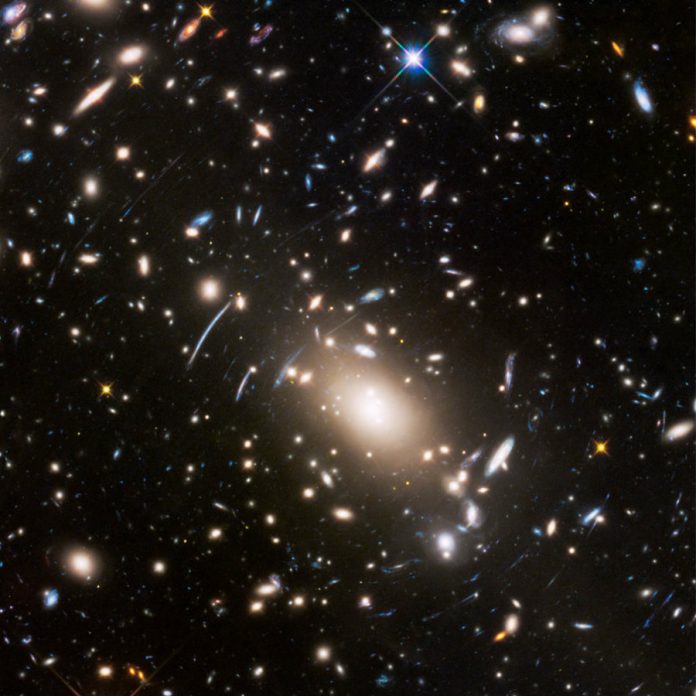
Just yesterday, as part of their Frontier Fields Program, NASA and the European Space Agency (ESA) released a new image captured by the Hubble Space Telescope (HST). The picture shows the distant galaxy cluster Abell S1063, to celebrate the 50th anniversary of original TV series Star Trek and today’s premiere of Star Trek Beyond, the latest film of the famous saga.
“Space… the final frontier. These are the stories of the Hubble Space Telescope. Its continuing mission, to explore strange new worlds and to boldly look where no telescope has looked before”, said the statement of the NASA/ESA Hubble in a clever allusion to Star Trek’s introductory speech used in the title sequence of most episodes.
The Hubble Space Telescope is a project of international cooperation between NASA and ESA, while the Hubble Frontier Fields is a three-year, 840-orbit program which will allow the human eye ‘to warp’ and see the “faintest galaxies in the distant universe.”
Illogical @StarTrekMovie careers that any Vulcan would love. https://t.co/qrztRqZKqc pic.twitter.com/2HfKd0CBsv
— SPACE.com (@SPACEdotcom) July 22, 2016
From Edwin to the Hubble
The Hubble Space Telescope was built by the United States space agency NASA, with contributions from the European Space Agency. The Space Telescope Science Institute (STScI) is in charge of the Hubble’s scientific operation and data delivery to astronomers, while the Goddard Space Flight Center controls the spacecraft.
Named after American astronomer Edwin Powell Hubble (1889 – 1953), his discoveries led to the widely accepted notion that the universe is expanding and that our galaxy, the Milky Way, was but one of millions out there. He helped kickstart the space fever, the desire to boldly go where no man had gone before.

The quest to launch space telescopes began in 1923, with the Hubble project finally being financed in the 1970s. Expected to launch in 1983, it was delayed by technical issues, budget problems, and the infamous Challenger disaster in 1986.
At last, the Hubble Space Telescope was launched into low Earth orbit in 1990, only to discover that its main mirror was compromised. The Hubble’s optics were corrected in 1993.
The HST is the only space telescope that is able to receive servicing missions from astronauts; the first one was in 1993 with the fixes mentioned above. Subsequently, there have been three more missions to repair, upgrade, and replace systems on the Hubble.
Following the Columbia disaster in 2003, a fifth mission was indefinitely canceled on safety grounds, being eventually completed in 2009. It was the Hubble’s final servicing mission.
Warping to new findings since 1990
One of the fundamental reasons for building the Hubble was to know the age of the universe. Before the telescope, astronomers had calculated it to be between 10 and 20 billion years old. Not exactly a precise measurement, as they couldn’t figure out the distances to remote galaxies and their velocities.
But with the Hubble’s top-notch resolution, astronomers determined the universe’s age to be around 13.8 billion years old. They were able to do so by calculating the current expansion rate of the universe, through the comparison of the brightness of suns all over the galaxy to others nearby.
When the Hubble was launched, black holes were believed to exist, being the result of supernova explosions. Not directly observable, astronomers knew they will be able to see them with high-energy X-rays and gamma rays, but their instruments couldn’t suffered to get through Earth’s atmosphere. Until HST came and allowed them to confirm their existence.
In the late 1990s, researchers Saul Perlmutter, Brian Schmidt, and Adam Riess embarked on a mission to measure how the the expansion of the universe has changed since the Big Bang. This time, supernovas, not suns, were used for the study.
If you missed #Hubblecast 90 on the Frontier Fields programme, you can watch it here: https://t.co/o0nUGlblLW
— HUBBLE (@HUBBLE_space) March 7, 2016
Using the HST, they observed that the brightness of the Type 1a supernovas in distant galaxies were much fainter than expected, discovering the dark energy and its repulsive effect to be the cause, and thus concluding that the expansion was speeding up.
In recognition for their discovery of dark energy, Perlmutter, Schmidt and Riess shared the 2011 Nobel Prize in physics.
About Frontier Fields
In 1995, Robert Williams, then director of the Space Telescope Science Institute, aimed the Hubble at an apparently empty region of deep space. Williams’ actions resulted in 342 images revealed of which 1,500 were never-before-seen galaxies. This initiated what would later be called the Hubble Frontier Fields program.
Officially named “Hubble Deep Fields Initiative 2012”, the program “will yield the deepest views of the Universe to date, combining the power of Hubble with the gravitational amplification of light around six different galaxy clusters to explore more distant regions of space than could otherwise be seen”, according to the HST website.
Hubble’s newest target is the distant galaxy cluster Abell S1063, believed to host billions of new worlds. Sixteen background galaxies have also been discovered, their light being distorted by the cluster’s dark matter. This findings will help astronomers understand the nature of dark matter, further proving the Hubble’s vital importance in astronomy.
Twenty six years ago, the launch of the Hubble Space Telescope became the turning point in answering and understanding the biggest mysteries of the universe; it was for astronomers what fire was to early humans.
Source: International Business Times











